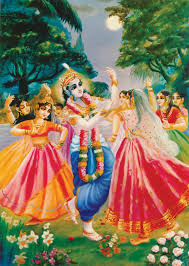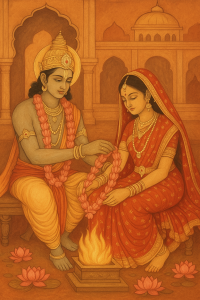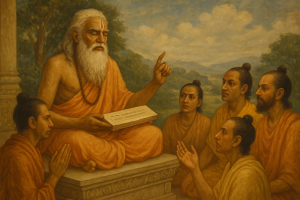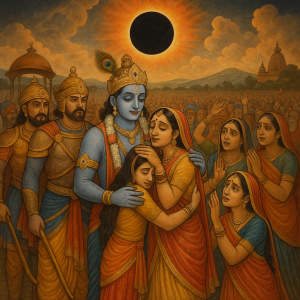The Call of Vṛndāvana
As the Mahābhārata war approached and tensions among the Kauravas and Pāṇḍavas rose, Lord Balarāma, the elder brother of Śrī Kṛṣṇa, chose not to participate in the battle. Though related to both sides, He wished to remain neutral and peaceful.
Instead, Balarāma decided to undertake a sacred pilgrimage across Bhārata-varṣa. Leaving Dvārakā with a group of brāhmaṇas and sages, He traveled from one holy tīrtha to another, performing ablutions, giving charity, and uplifting devotees by His presence.
Arrival in Vṛndāvana
Eventually, Balarāma reached Vṛndāvana, the sacred land where He and Kṛṣṇa had spent their childhood. The people of Vraja—Nanda Mahārāja, Mother Yaśodā, and the gopas and gopīs—welcomed Him with tears of joy.
The cowherd women cried out:
“O Dauji! You have returned after so many years!”
Though Kṛṣṇa had gone to Mathurā and Dvārakā, Balarāma’s return brought back the sweet memories of their childhood pastimes. He offered respectful obeisances to His parents and elders and spent several days joyfully reuniting with His kin.
Rāsa-Līlā with the Gopīs
In the evenings, Balarāma would enter the groves of Vṛndāvana along the banks of the Yamunā. The gopīs, who remembered His divine childhood form, gathered around Him with great affection.
One evening, under the full moon, the Yamunā flowed gently, flowers scented the air, and divine music played. At that time, Balarāma performed His own rāsa-līlā, dancing with the gopīs in ecstasy.
To serve Him, the Yamunā devi herself changed course, flowing closer to Balarāma’s feet. Delighted, He bathed, drank her waters, and blessed her:
“You shall be glorified forever, O Yamunā, for your devotion.”
Thus, Balarāma revealed His divine form and loving pastimes in the sacred forest, just as Kṛṣṇa had once done.
Lifting the Plough in Justice
During this time, Balarāma also visited Kurukṣetra, where a dispute had arisen between the Kauravas and King Sāmba (Kṛṣṇa’s son) regarding the marriage of Lakṣmaṇā, daughter of Duryodhana.
The Kauravas had insulted and imprisoned Sāmba. On hearing this, Balarāma demanded justice. When the Kauravas refused, He became furious.
With His plough weapon, He threatened to drag the entire Hastināpura city into the Ganges, shaking the earth with His divine strength. Terrified, the Kauravas begged forgiveness and released Sāmba.
Thus, Balarāma upheld dharma without siding with politics, showing that true strength lies in righteousness.
Lessons to Be Learned:
- Balarāma represents strength, justice, and purity. He does not favor one side over another, but protects truth.
- The Lord may abstain from conflict but never ignores adharma. When justice is violated, He rises to defend the innocent.
- Even the eternal companions of the Lord, like Balarāma, have their own loving pastimes and rasa-līlās.
- The gopīs’ devotion to Kṛṣṇa and Balarāma is not limited to youth, but continues eternally in love and service.
- Pilgrimage, when performed with sincerity, connects us with the divine and brings peace even in times of war.
Origin of the Story: Harivaṁśa Purāṇa – Viṣṇu-parva, Chapters 108–112



